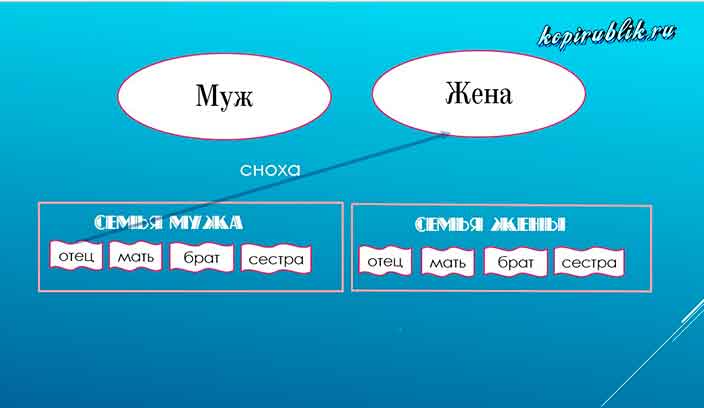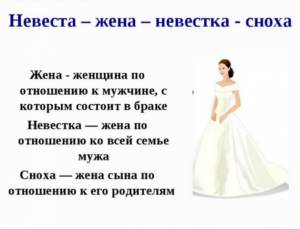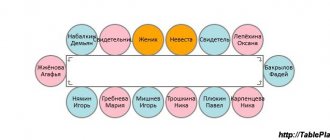Old meanings of words
Ancient dictionaries define the term daughter-in-law as the wife of a son. Due to the presence of a clear hierarchy of kinship in Slavic families, linguists trust this version most of all. Moreover, the concept applied both to blood relatives and to children who came into the family through marriage. That is why if the groom's father called the bride his daughter-in-law, then the mother called her daughter-in-law.
However, if we recall ancient legends and proverbs, as well as traditions, then most often they mention the terms daughter-in-law and daughter-in-law. At the same time, the male line is practically not involved. It follows from this that the father-in-law has minimal relation to the daughter-in-law. Consequently, such a combination of connections could not be firmly established in the everyday vocabulary.
The second version from historians and linguists is inclined to believe that the girl became a daughter-in-law after the birth of her first child in a new family. This version is considered more plausible due to the fact that after the birth of the child, the daughter-in-law already acquired some experience and could become a full-fledged part of the family. And the birth of a child was directly associated with blood ties. Consequently, it was after this event that the girl became a full-fledged daughter-in-law.
It is worth noting that despite the greater rights of a daughter-in-law than a daughter-in-law, her role in the groom’s family was in last place. But if the husband had a brother, then the girl could compete with him for the right to leadership.
The meaning of the interpretation of “daughter-in-law”

Despite the obviousness of the semantic background, the question is quite relevant: “Can the same person be a daughter-in-law and a daughter-in-law?”
Indeed, the term has one rare feature characteristic of concepts reflecting family ties and social status of people - dependence not only on the essence of the object or phenomenon that it describes, but also on the status of the person using it. In this case, the son's wife will be a daughter-in-law only in relation to the husband's father - the woman's mother considers her a daughter-in-law. The above concepts are often confused, so we recommend that you pay attention to a small feature and use your vocabulary correctly.

The figure schematically shows spouses with families, including brothers and sisters. The arrow indicates the linguistic relationship between the husband's father and his wife.
Modern meaning of the word
As mentioned earlier, in the modern lexicon the word daughter-in-law has almost completely lost its original meaning and influence. Most modern people are more familiar with the term “Daughter-in-law,” and it is used even after legitimate grandchildren appear in the family. At the same time, the man’s mother’s status and marital status are updated to the role of grandmother. But the daughter-in-law must also climb the hierarchical ladder after such an important event. Accordingly, the term daughter-in-law was invented for such cases. In later historical times, the daughter-in-law had more rights than before and such a title was considered honorable. Thanks to its clarity, such a tradition almost completely satisfies the requirements of the Slavic peoples.
Scientists explain the question of why the term daughters-in-law and daughter-in-law has become less used in the modern lexicon by the fact that the modern generation pays less attention to the importance of family ties. But in some remote places, adherents of ancient traditions still use this term. It is believed that it is the villages, least touched by civilizational society, that are the true guardians of Russian traditions.
Due to the growing interest of the modern generation in the historical past, scientists have only recently begun to seriously study this issue. But most of the traditions of the Russian people go back to the era of pre-Christian culture. Scientists agree that it was the Slavic people who had one of the clearest hierarchy structures in families. The East Slavic family of peoples has such a precise hierarchy that everyone is taken into account, even the most distant relatives after several generations.

A modern view of the family
These days, family members are not as close as they used to be. Now the newlyweds are striving to live separately from their parents and are looking for independence in the personal and financial spheres. Largely because of this, the true meaning of the word “daughter-in-law” or “daughter-in-law” is lost.
On the one hand, this is good; a new unit of society is being formed, with its own charter and rules. The life of all family members remains as usual, and the occurrence of problems is reduced to a minimum. On the other hand, a certain connection between generations is lost, the sense of duty and responsibility becomes blurred. Indifference and disrespect for elders is becoming more and more common.
However, using simple words will not bring deep moral principles back to life; this can only be done by fostering love and trust between generations.
What is a daughter-in-law like?
Sometimes you can come across the following opinion from researchers that a daughter-in-law is a spouse for the groom’s father. And a daughter-in-law is in relation to the mother of a son. If you dig deeper, it turns out that the concepts of “daughter-in-law” and “bride” are similar, but the powers of these statuses differ. In modern terms, daughter-in-law means:
- unknown;
- not to lead;
- foreign;
- from someone else's family.
That is, the concept denoted a girl whom the family might not fully trust, and when communicating with her one had to keep one’s ears open.

Let's remember a little history
Turning your gaze back to the depths of centuries, you can find that it was in those distant times that the foundations for naming family ties were laid. In comparison with other European countries, the system in Rus' was quite complex and multi-level. This is primarily due to complex family ties, which largely depended on financial issues.

All the husband’s relatives knew who the daughter-in-law was, and that’s what they called her. Whereas the girl separated them based on her position in the family. Over time, the wife's family members also received their names in relation to the husband and his relatives.
Blood or other ties connecting people in those days were the basis for the formation of the main unit of society. The families were quite large, connections were built not only linearly, the list included first cousins, second cousins and complete strangers who were once accepted into a narrow circle.
What does the status of a daughter-in-law mean and who is she?
This term has several versions of origin and pronunciation. For example, according to the old version, the word is pronounced “son”. In the Bulgarian language there is a similar meaning of the word son, that is, in this situation, the daughter-in-law was literally almost equal in rights to the son. According to linguists, this is the name given to the girl who gave birth to the groom’s first child. It was after the birth of the first child or twins that a woman could be called a daughter-in-law with full rights.
There is a version that the verb word “to bear” did not mean to give birth, but was used in the sense of patience. The fact is that in ancient times, after joining a new family, a girl had to adapt to new conditions, as well as endure many inconveniences and nagging from the groom’s relatives. If she can pass all the tests with dignity, she will receive a new status.

Modern usage
Today, the use of these two words can be found quite rarely. This is due solely to the fact that in modern society the line between these two concepts has become blurred. People simply don’t know what to properly call a married woman in her own family. Even after the birth of a child, a mother-in-law can call her son’s wife a daughter-in-law, only because she has no idea what exactly this word actually means. But she should know that as her rank increases, as a grandmother, the status of her son’s wife should correspondingly increase.
It is believed that daughters-in-law get a lot from their mothers-in-law, but daughters-in-law, on the contrary, are very loved.
The difference between the concepts of daughter-in-law and daughter-in-law
After a detailed consideration of the most popular versions of the origin of these words, certain conclusions can be drawn, namely:
- daughter-in-law is the wife on the son’s side;
- the concept of daughter-in-law meant a girl unfamiliar to a man’s family whom he wants to introduce into his family;
- A girl can be called a daughter-in-law by both the father and the mother on the son’s side.
The daughter-in-law has a common meaning for all family members on the male side. The difference is that if only the husband’s mother or father refers to the new bride as daughter-in-law, then both parents and other family members can call daughter-in-law, regardless of the degree and distance of the relationship. The word is so universal that even the wives of their husband’s brothers can call a new girl in the family a daughter-in-law.

Sister-in-law - who is she?
As many stories say, one of the main “enemies” of the daughter-in-law was the groom’s sister or sisters. When they were young, they were sisters-in-law. Many literary works describe the unfriendly attitude of sisters towards their daughter-in-law. Most likely, this is caused by jealousy. If earlier a brother’s love had to be shared only with his mother and father, now a new girl appeared, who created a certain distance between the young man and his sisters.
Now, understanding who the sister-in-law and daughter-in-law are, one can clearly imagine a picture of the life of these two people in distant times. The latter had practically no rights in the new family; sometimes she was not even allowed to eat at the common table. The first was still in the circle of loved ones and felt confident, although she perfectly understood that sooner or later this would happen to her.

What modern dictionaries say
Dictionaries do not provide a specific and uniform version of the origin of these words. Different editions give quite contradictory interpretations on this matter. Linguists say the following about the origin of these terms.
Often in families with an old way of life they would talk about their son’s new girlfriend when he brought her into the house, saying that he had brought who knows who. There is also a theory that the bride was called this word before the birth of her first child. The logic is that if before the birth of the child the girl was unknown to her husband’s family, then after the first child a thread of consanguinity appears. It was the birth of a child that indicated that the girl was officially moving to a new status. After such a feat, younger family members were obligated to listen to her opinion on a number of issues.
Who is the daughter-in-law?
The daughter-in-law is the wife of the husband. Only the husband's mother could call the newlywed this way.
In some sources, on the contrary, only the son’s father used this word to call his new “relative.” In some houses, it was the mother-in-law who called the woman this way.
Based on historical data, linguists have tried to reconstruct the picture of the hierarchical ladder within the family.
From this definition the word originated. In many ways, the origin is determined by the region of residence and customs.

How a girl received the “title” of daughter-in-law:
- When the son brought his young wife into the house, everyone avoided the girl. For a long time we could not decide on the type of relationship and feelings.
- Over the course of some time, they got used to their son’s young wife and got used to it. However, the title did not change.
- All her husband's relatives called the girl a daughter-in-law: brothers, sisters and other residents of her husband's house.
- When a blood relationship appeared between births - a girl gave birth to a child, her title was changed to daughter-in-law.
The daughter-in-law's responsibilities were determined by the household needs of the family: cooking in the kitchen, cleaning the house, harvesting, washing, heating.
Only over time did a woman acquire the right to vote in serious issues and affairs.
What Wikipedia says
A popular dictionary on the Internet claims that this word was previously used to describe a son’s wife in relation to the man’s father. Moreover, only the husband’s father has the right to call a girl this term. Any member of a man’s family, regardless of the degree of relationship, can also call a girl a daughter-in-law before the birth of a child. In this case, the brother’s wife will be the brother’s wife. Yatrovka is a lesser known synonym for intercourse. And a cousin’s wife was called a bro. Nowadays women are not generally called bro.
As a result, we can say that a daughter-in-law or daughter-in-law is a designation of the status of one woman. Only she is called differently, relative to a man. Each relative usually decides for himself what term to call a new family member. Such traditions have been preserved in the modern version. “Daughter-in-law” is rightfully considered a more familiar and widespread term. The new woman in the house is now sometimes called daughter-in-law by the husband's parents.
Etymology of the word "daughter-in-law"
In order to better understand the semantic meaning of the word, it is necessary to turn to its origins. Our ancestors put meaning into everything, conveyed their feelings and emotions. Today, a science such as etymology helps us discover the secrets of the world of words. So, almost anyone can tell who the daughter-in-law is, but not everyone knows the story behind these letters. Let's lift the veil of secrecy.
The word comes from a simple word - “bride”, which, in turn, carries the entire main meaning.
It used to be that the young wife, after the wedding ceremony, moved to live in the groom’s house. The families were large, but not always rich, so getting separate housing was not part of the couple’s immediate plans. They lived with their husband's parents, brothers and sisters.
The new family member was a mystery to those around him; no one knew what to expect from the girl. “Unknown” - that’s what a daughter-in-law is by definition. For a long period, the husband's family looked closely at their new relative, studied it, and got used to it.

Final conclusions
The main task of such terms is to emphasize, to highlight from the general mass of people who play an important role in the life of not only an individual, but also the entire society.

Answering a simple question about who a daughter-in-law is, we touched on a deeper topic - a change in the emotional component of words. And there are many such examples. Delving deeper into etymology, you can discover thousands of amazing and striking examples. Knowing the origin of the word, its true meaning, we have the opportunity to make our speech more rich, truthful and open.










